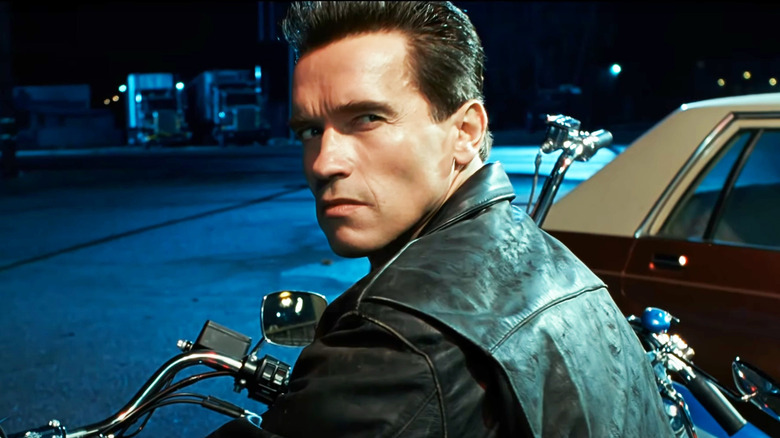Why James Cameron Thought Terminator 2 Was A Perfect Fit For A 3D Release
James Cameron isn't averse to reminding people why he's the GOAT. Back in 2017, the veteran director spent $7 million bringing his masterful "Terminator 2: Judgment Day" back onto screens in 3D form. Its re-release came 26 years after it first hit theaters back in 1991 (Cameron just missed the 25th anniversary) and there was every reason to revisit the film after so long.
"T2" is one of those rare blockbusters that not only tops the original movie in almost every way, but that holds up after the best part of three decades. The innovative action masterpiece was celebrated on its release for everything from its pioneering CGI and practical effects to its rock solid performances and impressive stunts. It also proved a massive hit, generating $515 million at the global box office on a $100 million budget. And those elements are just as powerful now as they were in '91.
Unfortunately, that widespread love for the original movie didn't translate to box office success for the 3D revival. Cameron's attempt to add a new dimension to his classic directorial effort was showcased in AMC theaters for one week across 386 screens. Alas, its opening weekend total of $582,000 was, whichever way you tried to spin it, disappointing. There were likely a number of reasons why the re-release flopped, with The Guardian's contention that "few truly give a fig about" the 3D format providing some insight into the problem. But that doesn't really matter to Cameron, who has been a long-time advocate of the tech. For a director who remains committed to the success of 3D, bringing back one of his biggest films was always in the cards. And, as it happens, he had some pretty specific reasons for why it was such a good idea.
Cameron was working in 3D before 3D
In an interview around the re-launch of the film, James Cameron made clear that he was aware that "T2" remains "very iconic" and as such deserved the re-release treatment. There was also a whole generation of fans who had only seen the film on "video, Blu-ray, and DVD," which also motivated the director to give them a way to get the full theatrical experience. But the 3D element was also a must-have for him, in large part due to the movie's style and technical shooting specs:
"Stylistically, the way the camera moves, the way the shots are composed and soon, I felt that it would convert very well ... My style tends to be shorter lenses anyway; some people use more 3 – 400 mm lenses and that never looks as good on a 3D conversion. But the Terminator 2 style, I felt would work well."
Cameron also credited his work on the Universal Studios ride "T2-3D: Battle Across Time," which saw him reunite with the original cast to shoot a mini-sequel to the movie in 3D. Though he said it was just a "subconscious association" between the ride and the 2017 re-release of "T2," Cameron stated that working on the ride reaffirmed that the "T2" cinematic style "would translate very well."
In fact, in a Q&A for the 2017 re-launch, Cameron said he would "absolutely" have shot "T2" in 3D had the technology been available in 1991, adding: "I think you can see from the shot design that I think in depth ... the camera is always moving to try to get the foreground and mid-ground to move against each other." Even before working with 3D technology, then, Cameron was trying to shoot his movies in as three-dimensional a way as possible.
No fate
There's so much about the "T2" re-release that's disappointing — and none of it is James Cameron's fault. Seeing such a lackluster coda attached to a genuine juggernaut of a '90s action movie itself is kind of sad. But considering the amount of work and attention to detail that went into bringing the film into the 3D realm, it's downright tragic that the whole enterprise wasn't more successful.
Originally shot on film using ARRIFLEX 35 BL4 Camera, Cooke Varotal Lenses, and Zeiss Super Speed Lenses, "Terminator 2" had to undergo a full 4K transfer that Cameron considers better than the 70mm prints he initially released when the film came out. The work to convert it to 3D could then begin and was handled by conversion house Stereo D, in tandem with a special team at Cameron's Lightstorm Entertainment. The conversion job took more than 1,400 artists who spent a year working on the project.
And it was all justifiable work. Cameron is right that the movie lends itself to a 3D conversion in the way it was shot. The T-1000 oozing through the smashed window of the helicopter outside Cyberdyne systems seems like a shot made for 3D — as do multiple other frames throughout the film. The way Arnie aims that shotgun directly at the camera in the drainage canal chase scene again speaks to the way Cameron "thinks in depth."
With all that in mind, we've only got ourselves to blame that the 3D re-launch wasn't more successful. We, myself included, didn't show up for our beloved "Terminator" sequel when it truly needed us, and as such have probably lost the opportunity to see the original "Terminator" given the same loving 3D restoration. As Kyle Reese once said, "There is no fate but what we make for ourselves."


